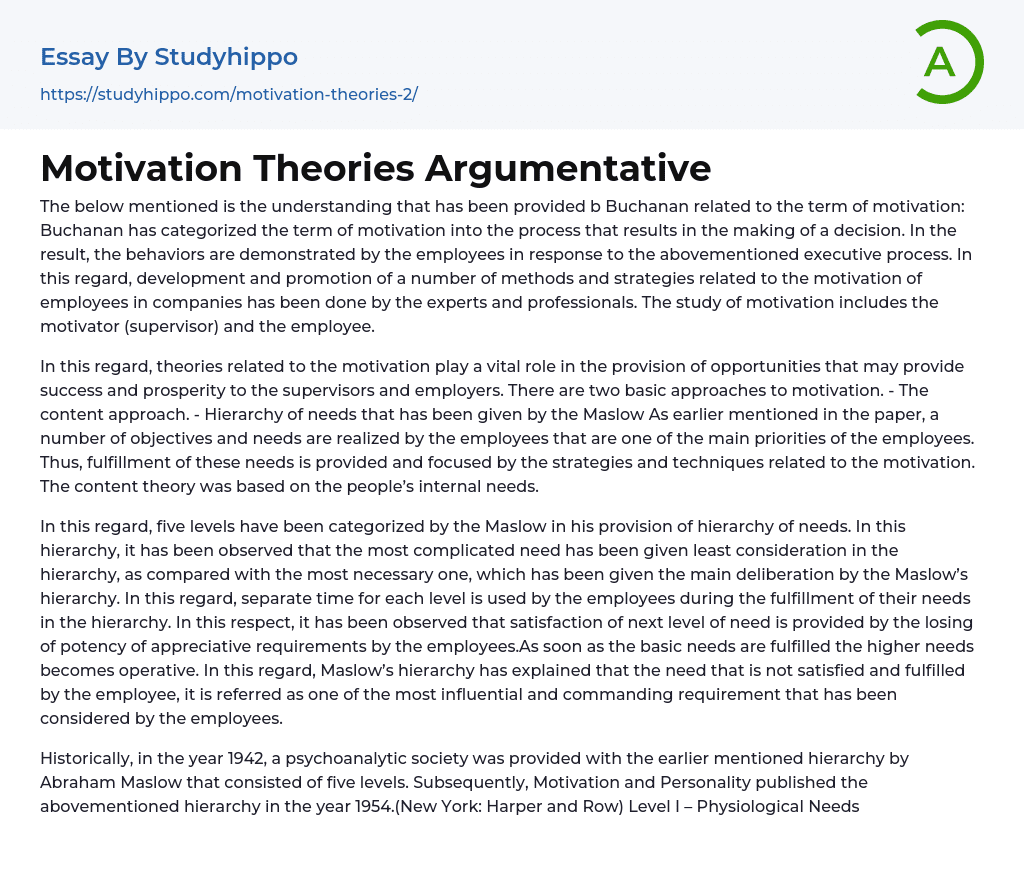Buchanan's understanding of motivation is that it can be categorized as a process that leads to decision making.
In response to the executive process, employees demonstrate behaviors. Experts and professionals have developed various methods and strategies to motivate employees in companies. The study of motivation includes the supervisor and the employee, and theories on motivation are crucial in providing opportunities for success and prosperity to supervisors and employers. There are two main approaches to motivation.
The Maslow hierarchy of needs, as mentioned earlier, outlines the various objectives and needs that are important to employees. These needs are a priority for employees, and strategies and techniques for motivation are centered around fulfilling them. Maslow's hierarchy of needs is based on internal needs, and he categorizes them into five levels.
The hierarchy proposed by Maslow prioritizes the
...most necessary needs over the more complex ones. Employees allocate separate time for each level of the hierarchy to meet their needs. It has been observed that when employees satisfy a higher level need, the potency of appreciative requirements diminishes. Once basic needs are fulfilled, higher needs become active. According to Maslow, an unsatisfied need holds significant influence and command for employees.
In 1942, Abraham Maslow provided a psychoanalytic society with a hierarchy consisting of five levels. This hierarchy was later published in the book Motivation and Personality in 1954 (New York: Harper and Row). The first level, known as Physiological Needs, refers to the basic needs and requirements that humans have identified in their lives, such as food, shelter, and water. These needs are satisfied through the organization's payments. The second level, known as Safety Needs, involves identifying and avoiding various forms of
harm and destruction to ensure personal security.
The organization strives to protect these needs through proper management and provision of specific benefits. Level III - Social Needs: Many experts have noted that human beings require association and engagement, leading to the development of friendships and connections based on their social needs. This allows employees to participate in society. The organization should offer additional activities such as sports, parties, and celebrations to fulfill these social needs. Level IV - Esteem Needs: Esteem needs refer to the desire for respect and recognition from others for one's work. The organization can meet employees' esteem needs by assigning projects that match their expertise and abilities. This boosts self-esteem and fulfills their needs.
Level V - Self Actualization Needs Every individual has unique capacities that are associated with their self-actualization needs. Therefore, employees recognize their self-confidence and potential through fulfilling these needs. The manager can assign challenging tasks that make employees feel stimulated, while providing them with comprehensive training and support. Certain factors, known as motivators or inherent ones, contribute to job satisfaction. Conversely, a range of factors, referred to as hygiene and extrinsic factors in human lives, lead to job dissatisfaction.
There are various theories on motivation that can be discussed briefly. One theory relates reward to employee performance. According to expert Vroom, reward is achieved through quality performance, which is the result of employees' efforts. Vroom's theory explains the idea of putting in effort to obtain rewards. In 1964, Vroom noted that rewards can be either negative or positive. The more positive the reward, the greater efficiency will be seen in performance.
On the one hand, if employees are given the least
appreciation, their motivation will be the lowest. Additionally, Adam's theory suggests that self-identification is a contributing factor to employee efforts.
In summary, competition among employees motivates them to prove themselves. According to Adams (1965), equity is achieved when the ratio of one employee's output over input matches the ratio of another employee's output over their input. Skinner (1953) supports the idea that positive behaviors demonstrated by employees should be repeated, while discouragement should be given to negative behaviors with a detrimental impact. Therefore, it is important for managers to foster and maintain positive employee behaviors in any organization.
- Self Assessment essays
- Self Evaluation essays
- Immigration Reform essays
- Abnormal Psychology essays
- Abraham Maslow essays
- Attachment Theory essays
- Authority essays
- Behaviorism essays
- Classical Conditioning essays
- Cognitive Psychology essays
- Counseling essays
- Developmental Psychology essays
- Educational Psychology essays
- Erik Erikson essays
- Family Therapy essays
- Jean Piaget essays
- Maslow's Hierarchy Of Needs essays
- Mental Health essays
- Operant Conditioning essays
- Personality Psychology essays
- Positive Psychology essays
- Psychoanalysis essays
- Psychotherapy essays
- Sigmund Freud essays
- Social Psychology essays
- Stanford Prison Experiment essays
- Supersize Me essays
- Bias essays
- Big Five Personality Traits essays
- Body Image essays
- Mind essays
- Motivation essays
- Phobias essays
- Thought essays
- Attitude essays
- Goals essays
- Personal Goals essays
- Personal Life essays
- Personality essays
- Principles essays
- Reputation essays
- Self Awareness essays
- Self Esteem essays
- Self Reflection essays
- Self Reliance essays
- Strengths essays
- Value essays
- Values essays
- Weakness essays
- Who Am I essays




